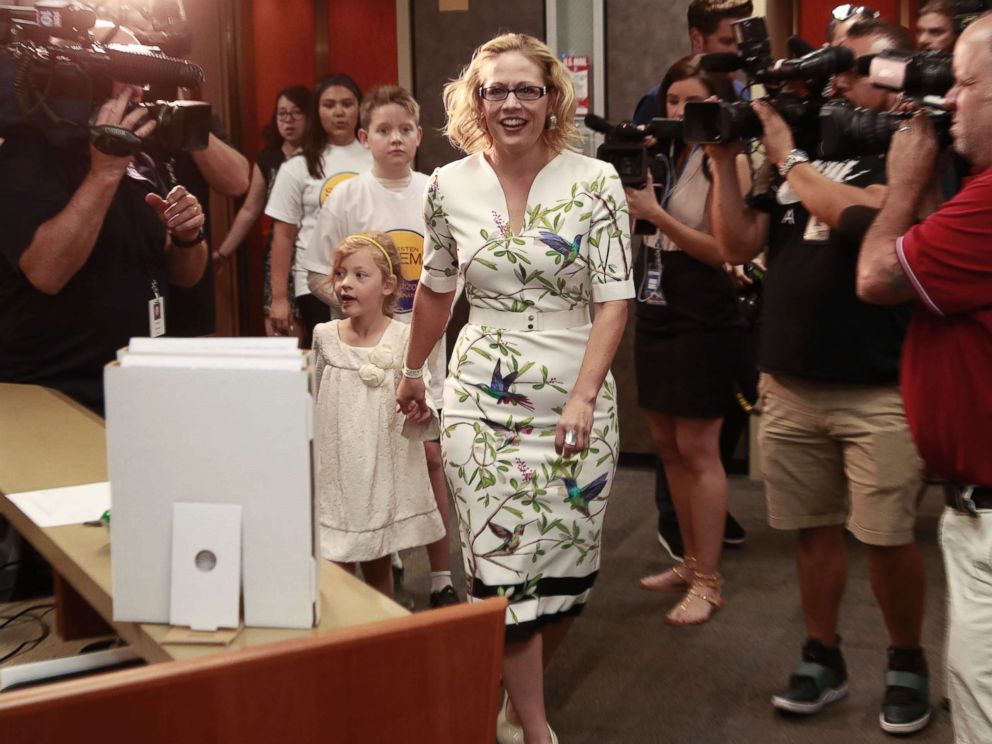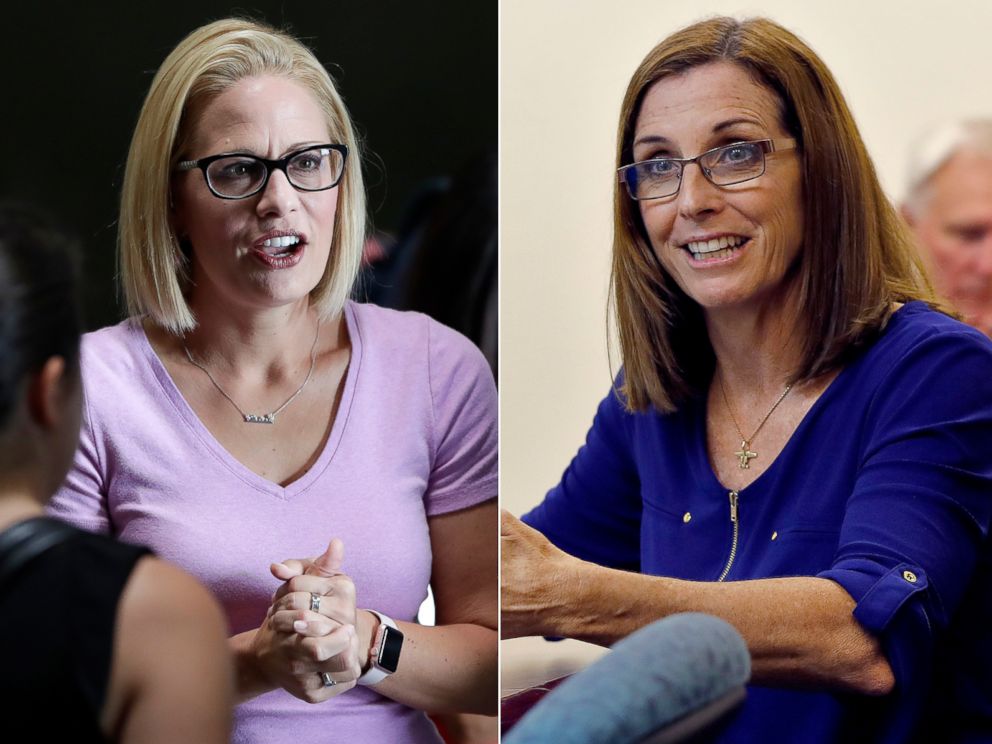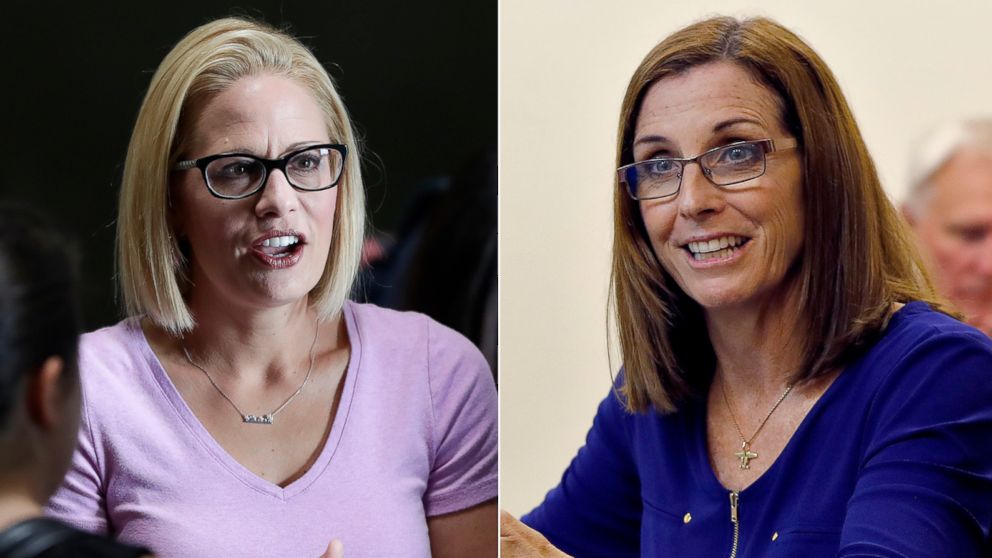[ad_1]

Calls for politicians to “grow a pair of ovaries” and digs about how many shoes a candidate have might sound like lines out of “Mean Girls,” but instead they’re attack lines being used in one of the most hotly contested midterm Senate races.
The gender dynamics at play in the Arizona Senate race may be surprising to some since the race is one of six this cycle that involve two female candidates, but it’s the only one where the two women are facing off for an open seat rather than an incumbent fighting against a threat.
The Arizona race is also unique in this time because it doesn’t fit neatly into the so-called ‘pink wave’ of female candidates who have been inspired by the current political climate to get involved.
Instead, both Democrat Kyrsten Sinema and Republican Martha McSally are three- and two-term congresswomen, respectively, who have represented different districts in the Copper state, looking to move up the political ladder to fill the Senate seat being left open by Sen. Jeff Flake’s decision not to run for another term.
Kelly Dittmar, an assistant professor of political science at Rutgers and a scholar at the Center for American Women and Politics, said that she believes McSally is “actually making a pretty gendered case… by positioning herself in contrast to Kyrsten Sinema who she’s been painting as highly feminine.”
Dittmar said that McSally’s ads and speeches paint a picture of “guts versus glitz, and literally says ‘I’m the candidate who’s’ tough and strong and she’s the candidate who is vain.’”
 Rick Scuteri/AP
Rick Scuteri/APMcSally has turned a 2006 interview Sinema gave to a now-defunct fashion magazine against her, citing how Sinema called herself a “Prada-socialist” who had more than 100 pairs of shoes. Sinema reportedly said that the interview comments were attempts at a joke, but that hasn’t stopped McSally from dubbing her opponent “Hollywood Sinema.”
The contrast was on full display in another McSally ad released in August.
In it, McSally talks about her time as the Air Force’s first female fighter pilot in combat, before cutting to footage of Sinema at a 2003 anti-war protest in a pink tutu.
“Both the rhetoric and the imagery that she’s been using to define Kyrsten Sinema has been… derogatory images of femininity… caring more about your shoes than your public policy,” Dittmar said.
Gloria Feldt, a part-time Arizona resident and the co-founder and president of Take the Lead, a non-profit org whose mission is leadership gender parity, said that the “pink tutu” ad was “a really sexist thing to say… what she was wearing was really irrelevant.”
“The use of that image is designed to diminish her strength, to diminish her credibility,” Feldt said.
Molly Nuñez, a spokesperson for Sinema’s campaign, dismissed the critiques as attempts to distract from the issues.
“Congresswoman McSally is relying on false attacks and smears to distract from her harmful record of threatening our access to health care and undermining Social Security and Medicare. It’s disappointing but not surprising that Congresswoman McSally will say and do anything to try to win an election,” Nuñez said in a statement to ABC News.
McSally defended her use of negative ads to ABC News.
“We have positive ads as well, but look, she [Sinema] had millions of dollars of creating an image that was false of who she is and we thought it was important for people to understand that that’s not accurate,” McSally said after a campaign event Saturday.
“They’re using sort of fear and character assassination while we’re trying to get the facts out of who I am and who she is,” McSally said.
The nuances of negative attacks
Kim Fridkin, a professor of political science at Arizona State University, said that overall this race “has been very negative, as you would expect in a competitive race,” but the gender of the candidates could also be contributing.
“I think when women are running against men, men are much more cautious about launching their own negative ads,” Fridkin said. “In this race, because it’s a woman versus a woman, we don’t really have that worry. Perhaps that’s one of the reasons it’s really negative.”
 Matt York/AP, FILE
Matt York/AP, FILESupporters have taken notice of the negative ads, with several attendees at a McSally event in Phoenix Friday complaining about the tenor of the ads on both sides of the race, but writing them off as an almost inevitable evil.
“I wish Martha would have more positive ads,” said Vermelle Bibler, a McSally supporter who attended the congresswoman’s event with former Gov. Mitt Romney Friday. “Sinema deserves it, but I wish Martha would have more positive ads.”
Dittmar said that it’s clear that “women candidates don’t all navigate and use gender in the same way.”
“Part of that is going to be informed by partisanship but also experience and background and all of those things are going to play a role,” Dittmar said.
Feldt said that McSally’s decision to shift from earlier Congressional messaging as something of “a relatively moderate person” to appeal to a “much more liberal progressive” voter base in Tuscon to her new hard-line Trump supporter could be a factor.
“Now that she’s running state-wide, she has full blown taken on the attributes of the most right wing of the Republican party which is almost classically patriarchal in its points of view,” Feldt said.
For Sinema’s part, she has been portraying herself as something more of a moderate, and her voting record shows it: 538 reports that she voted with the Trump administration 62.2 percent of the time. There are only three other Democrats who have sided with the Trump administration more.
 Matt York/AP, FILE
Matt York/AP, FILEMcSally, who has featured soundbites from President Donald Trump in her ads and even had an email sent to her followers on his behalf, voted with the administration 97.8 percent of the time, according to ABC News partner FiveThirtyEight.
“It’s a reminder that even if you’re in an all-female race it doesn’t mean that the way in which candidates perform and navigate gender isn’t very different,” Dittmar said.
A major milestone
One history-making aspect of this race is that the winner will inevitably be Arizona’s first female senator. Fridkin notes that the state has had multiple female governors and congresswomen, obviously, so she doesn’t think that Arizonans will see electing a woman to the Senate as a major milestone.
“I don’t think that Arizona’s not ready for a woman U.S. Senator,” Fridkin said.
One woman who wished that were she is Kelli Ward, who lost in the Republican primary to McSally. Speaking to ABC News after the primary, she said that she thinks that Arizonans “are very open to women being in positions of influence and leadership” but the gender of a candidate is not “our number one issue.”
That said, Ward said that she feels female candidates are held to a different standard on the optics level, telling of how after a campaign speech at a medical convention, one listener had an unexpected takeaway.
“After the presentation, a guy who was 77, said ‘You really need some powder on your forehead because the shine was very distracting.’ I just thought, ‘Wow, there was so much information there about policy and solutions and you’re focusing on my forehead,’” Ward said.
“It’s harder for women candidates across the board, whether they’re Republicans or Democrats. Whether it’s admitted or not, there is gender bias that’s out there, everything from what you wear to how your voice sounds to whether your eyebrows are the shape they’re looking for,” Ward said. “We’re subconsciously or consciously judged by our outward appearance and that makes it tough for everyone.”
[ad_2]
Source link

